How to Write a Multiplication Expression Using Rows and Columns
With either the picture or the expressions, it is nothing short of a miracle that 4 × 3 = 3 × 4. Children can, of course, rearrange objects grouped as 3 + 3 + 3 + 3 to show the equivalence to 4 + 4 + 4, but it takes rearranging, and is not "obvious."
But if the same cookies are arranged on a tray in rows and columns, it's perfectly obvious that any way we hold the tray, the number of cookies is the same. Even if we have a preference for how we label the first two pictures below (insisting, for example, that one is 4 × 3 and the other is 3 × 4, which mathematicians do not do), we have no way of making such an assignment for the last tray. 4 × 3 simply equals 3 × 4, even though the notations are not the same.
If we describe the "three plates, four cookies each" picture using a repeated addition expression, then 4 + 4 + 4 is more "natural" to use than 3 + 3 + 3 + 3. But if we describe that picture with a multiplication expression, 3 × 4 and 4 × 3 are equally correct; there is no mathematically preferred order for writing the multiplication expressions.[1].
It is useful and possible for young students to develop an idea of multiplication that does survive the transition from whole numbers to fractions and decimals. Of course it is also useful to see how multiplication can simplify a computation that would otherwise require repeated addition, but that should not be multiplication's primary image and, for that reason, preferably not its first image.
In Think Math! multiplication is associated primarily with arrays and intersections, and connected quite early with "combinations" (including simple pairings) of things: streets and avenues, vowels and consonants in two-letter words, and so on. The repeated addition idea is presented, too, but later, as an example of another kind of problem that multiplication solves.
Given the number of rows and columns in a rectangular array, multiplication tells us how many elements are in the array without making us count them one by one or repeatedly add (or skip count) the elements in each row or column. When the elements in the rows and columns happen to be squares aligned side-to-side, multiplication counts those squares, and therefore tells us the area of the rectangle. This image works perfectly even for fractions and explains the algorithm for multiplication of fractions.
If the three-by-four rectangle is placed "level" one way, it has 3 rows and 4 columns  ; if we rotate it 90 degrees, rows become columns and columns become rows, so it will have 4 rows and 3 columns
; if we rotate it 90 degrees, rows become columns and columns become rows, so it will have 4 rows and 3 columns  . If it is held at a slant, there is no rule that says which to call rows and which to call columns, but it doesn't matter anyway; the number of squares inside it is the same. It also doesn't matter which order we label the width and length of a rectangle: 3 × 4 and 4 × 3 label the same rectangle, regardless of how the rectangle is held. The two expressions, 3 × 4 and 4 × 3, name the same number. Combinations: How many possible blocks can be made with exactly three colors and four shapes? (Assume each block is one color and all blocks are the same size.) Questions of this kind suggest another image (and use) of multiplication.
. If it is held at a slant, there is no rule that says which to call rows and which to call columns, but it doesn't matter anyway; the number of squares inside it is the same. It also doesn't matter which order we label the width and length of a rectangle: 3 × 4 and 4 × 3 label the same rectangle, regardless of how the rectangle is held. The two expressions, 3 × 4 and 4 × 3, name the same number. Combinations: How many possible blocks can be made with exactly three colors and four shapes? (Assume each block is one color and all blocks are the same size.) Questions of this kind suggest another image (and use) of multiplication.
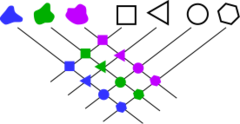
In fact, multiplication is suited to any situation in which elements of one set are paired in order with elements of another set. Here, the elements of one set are beginnings of "words" and the elements of the other set are endings.
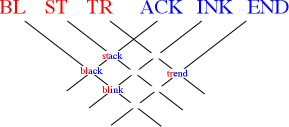
A hint at the relationship with the multiplication algorithm.
See the article on multiplication and division for a full development of a multi-digit multiplication algorithm, showing how it is a faithful record of the intersection/area models shown here.
Unlike addition, which combines only like quantities (hundreds with hundreds, ones with ones), multiplication makes all the pairings (3 ×7, 3 × 40, 3 × 200, 80 × 7, 80 × 40, 80 × 200)


For the purposes of performing a multi-digit multiplication, the "intersections" image shown above is inconvenient, because it scatters the partial products in a way that is a nuisance for the final required addition step. For the purposes of understanding how to organize the computation, a tabular representation of the combinations is easier, and also introduces the array/area model.
This way of thinking about multi-digit multiplication is the basis of the Vedic multiplication of India. This can be a fascinating cultural side topic for students who have learned to multiply multi-digit numbers.
Arrays and the multiplication table
Early in second grade, children can solve and enjoy problems like these.
Here are two red letters and three blue letters: A, I, S, N, T . How many two-letter words can you make beginning with a red letter and ending with a blue letter?
How many two-block towers, exactly this shape  , can you make with these blocks?
, can you make with these blocks? 
Here are two examples: 
 . How many others can you make?
. How many others can you make?
Children can perform the experiments, creating the actual combinations, and they can invent their own system for recording these combinations. In the case of the two-letter words, just writing the words will do. With the towers, children might draw them, or might indicate the color combinations in some more abstract way. When the number of possibilities is small enough, as it is with the two-letter words, second graders quickly find all the possibilities.
Intersections as a model for making an organized list
When the number of possibilities is greater, as it is with the block-tower problem, children tend to miss combinations, or double-list them, unless they are systematic.
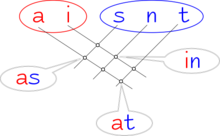
Here is one way to visualize the pairings in these two experiments.Each intersection represents a combination.The × symbol itself is connected to the intersection imagery, the crossing of lines.
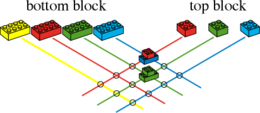
Children can "drive" their finger along "A street" and "N avenue" and label the stoplight at that intersection "an."They can check that they have a tower for each intersection: the intersection of blue-bottom and red-top for example.When second graders first perform these experiments, they are learning how to make systematic lists, not about multiplication. But we can see where this leads: the intersections, themselves, itemize the combinations that the children are looking for and help them see how to organize those lists; the number of intersections can be found by multiplication, and children are getting a preview of those multiplication ideas.
Tables as a model for making an organized list
Tables are equally good for representing the combinations and organize the task of listing them. The cells inside the table (and carefully avoiding getting confused with the "header" cells above each column and to the left of each row) again show how multiplication answers the question "how many pairings can be made?"


Mathematics uses both structures — tables and intersecting lines — extensively.
Multiplication is often represented by arrays of adjacent squares — the "area model" of multiplication — or by arrays of dots or other small objects. The former are visually more like the insides of tables; the latter are visually more like intersections.Anchor
Building the basic facts
First steps
When we see the same triples of numbers — 3, 5, 15; 4, 3, 12; 2, 5, 10; 6, 4, 24 — popping up in different contexts, they begin to feel familiar even before any conscious effort to memorize them. In fact, the focused, deliberate effort that seems to be needed for some triples (like 7, 8, 56) may be precisely because there are so few natural contexts in which those triples otherwise appear. Many non-school experiences help build the 5-times table: experience telling time in minutes on the clock, handling nickels, noticing one's hands. The following ideas present several contexts for the same basic facts to vary the practice (to keep it interesting and build a rich variety of imagery) so that by the time children are trying to memorize multiplication facts, they are already so familiar with the most common ones that they know them "cold," and the number of remaining facts that require rote memorization is quite small (only fifteen!).
Doubling and halving
In first grade, children learn to double ([[mental arithmetic|mentally]) all whole numbers up through 12. Second graders practice these basic doubles further by using them, along with their developing ideas of place value, to double (mentally) whole numbers through 50. Children in these grades also learn to find half of the even numbers that result from such doubling.
Small arrays
In Think Math!, the second half of second grade gives students a lot of experience with small arrays from which they can memorize small multiplication facts. In one activity, the teacher might hold up an array like this and ask "How many rows? How many columns? How many little squares?"

Students who are not yet fluent with addition might use addition or skip counting to figure out the number of squares. Associating the dimensions of the array — the number of rows and columns — with the number of little squares establishes a multiplication fact.
The teacher might then hold the same array in this orientation and ask the same questions.

Rows and columns are interchanged, but the number of squares remains the same.
The teacher can make a lively game of this by varying what array is held up (2×3, 3×3, 4×5, etc., never with more than 5 rows or columns, because the larger numbers are too hard to recognize without tedious counting), and students fairly quickly come to remember how many squares in these familiar rectangles.
The fact that a rectangle, held horizontally or vertically, has the same number of small squares inside it gives a graphic understanding of why multiplication is commutative.

Intersecting vertical and horizontal lines provide another image for multiplication — 2 vertical lines cross 3 horizontal lines in 6 intersections — and another context in which to rehearse the facts. They might draw these, or might play with transparent cards, first trying to predict the number of intersections and then overlapping the transparencies to count directly to test their predictions.Cards with slots in them are fun to play with, too. Children pick a pair and, as with the transparencies, try to picture the number of intersections before they actually experiment by placing one card on top of the other to see if their prediction was correct. If a card with 2 vertical slots is placed on top of a card with 5 horizontal slots, we can see through the double layer only at the 10 intersections.
Intersections to clarify multiplication by 0 and 1. "Imagine a tiny town, with three roads going east-west…" Sweep your finger through the air horizontally to help describe what "east-west" means. Then "draw" two more east-west roads, just in the air, for children to picture in their heads. Later you or a child will actually draw these on the board."…and only one road going north-south."
In the air, indicate the north-south road with your finger.
"Let's draw a map of this tiny town. Here are the east-west roads."
Draw an irregular boundary for the town, and in it draw three parallel horizontal lines from one side of the town to the other side (and extending slightly outside the town border to indicate that they keep going into the neighboring regions).
"On the map, the roads just look like three horizontal lines. Who would like to draw the north-south road?"
You might again indicate the direction with your finger in the air, but not directly on the map. Invite someone to draw.
"The town put a stoplight at each intersection (point to the intersections). How many stoplights are there?"
Play with the image.
"What if the town built another east-west road? How many intersections would that make?"
Multiplying any number by 1 gives that number; multiplying any number by 0 gives 0. Children who are taught these just as rules to memorize, without some understanding, often garble the rules, confusing them with each other. (Does 1 times a number give 1 or the number?) The tiny town image helps establish why 1 times any number gives that number. (With only one vertical line, the number of intersections will be the same as the number of horizontal lines.)

Cards with 0 through 5 slots in them can also be especially useful. When a card with a single vertical slot is placed on top of a card with three horizontal slots, the three intersections appear as the only "windows" through the pair of cards. Changing which card is placed on top, or which is vertical and which is horizontal, makes no difference. If one card has a single slot, the number of intersections will match the number of slots in the other card when they are superimposed (and the other slots are perpendicular to the single slot).The slot image makes it particularly clear why multiplication by 0 always gives 0. 
This lesson gives a nice opportunity to use the words horizontal and vertical in context and to connect their use as directions on maps with East, West, North, and South as directions on the earth. (See horizontal and vertical for common confusions about the ideas these words represent.)
Building a multiplication table
A student project for second grade: Students use a grid that is laid out like a multiplication table, but does not have a row or column for zero. Using a backward-L-shaped piece of paper, they select a part of the grid; in the bottom right-hand corner of the selection, they write the number of squares they captured (which is the same as the area of the rectangle if each little square represents one square unit of area).
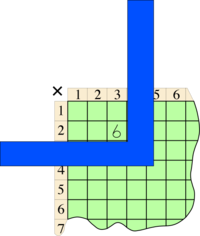
Notice that the number at the top nearest the blue boundary gives the width of the green rectangle, the number of columns of squares; the number at the left nearest the blue boundary gives the height of the green rectangle, the number of rows it has.
If we move the boundary straight down one step, we add a new row without changing the number of squares per row.
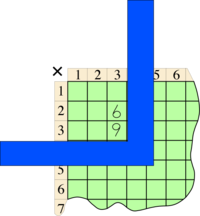
This way of thinking say that 6 (the number of squares in the previous rectangle, 2×3) plus 3 (the number of squares in the new row) equals 9 (the number of squares in the new rectangle). Another way to describe the new rectangle is 3×3. So 2×3 + 3 = 3×3.
This rectangle happens to have the same width and height, so it is a square. The number in the corner (the number of tiny squares inside it) is therefore called a square number.
A diagonal move — one step "South" and one step "East" (or one step down and one step to the right) — gives another square number.

Two south-east diagonal steps gives another square number.

Interestingly, if you start at a square number (in this case, 16) and take one step northeast
or southwest
the resulting number is exactly 1 less than the square number on which you started. This example shows the 3×5 rectangle contains one fewer square than the 4×4 rectangle. See the article on difference of squares for more about this intriguing pattern and another particularly effective way for students to practice facts while developing new and useful mathematical ideas.
Symmetry of multiplication table
Counting squares in the rectangles makes it clear why 3×4 = 4×3. Both are ways of describing this rectangle  . And even if we decide to reserve one of those notations for
. And even if we decide to reserve one of those notations for  and the other notation for
and the other notation for  , the two would still be equal.
, the two would still be equal.
Because multiplication is commutative — that is, because 2×6 = 6×2 and 3×5 = 5×3, and so on — the multiplication table is symmetric around the northwest-southeast diagonal. That diagonal, yellow in these illustrations, contains the square numbers.

Getting rid of the distracting numbers and arrows, we see three regions: the diagonal with square numbers, the green region with other products, and the white region, with the same numbers that are in the green region.
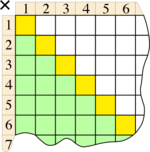
That's very good news for anyone trying to memorize multiplication facts! (See How many facts to learn? below.)
Multiplying by 10 and 100
Under construction: 7 rods is 70 small cubes
Multiplying by 5 and 50
Children who can multiply by 10 and can take half can then use those skills to multiply by 5. For example, 7×5 is half of 7×10, so it is 35. Ultimately, 7×5 should just be recognized on its own — one of the "basic facts" — but the two-step procedure (multiplying by 10 and then taking half of the result) is valuable to know as well, and a good connection to make with the 5-times facts. Similarly, knowing that 50 is half of 100, we can see that 50 sevens is half of 100 sevens, so 50×7 is half of 100×7: we can multiply any number by 50 by multiplying by 100 and then taking half. Children who learn this well can easily multiply 18×5 in their heads by thinking "half of 180." Because multiplication and division can be done in either order with the same result, we could take half (of 18) first and then multiply by 10.
How many facts to learn?
If multiplication by zero and one are understood, those facts (light blue) don't need to be memorized. If the symmetry of the table is understood (3 × 4 = 4 × 3, the commutative property of multiplication), those facts (dark blue) don't need to be memorized. By the time that children are working on fact practice, the square numbers (yellow) are already learned, and the "easy" facts (pink) are already learned (doubles, multiplication by 10, and multiplication by 5). At that point, only 15 facts — the ones in green — remain to be memorized.
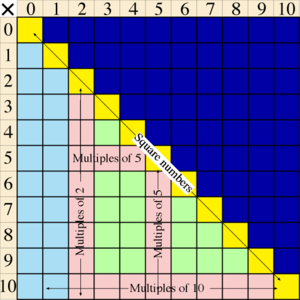
How to Write a Multiplication Expression Using Rows and Columns
Source: https://elementarymath.edc.org/resources/multiplication/


0 Response to "How to Write a Multiplication Expression Using Rows and Columns"
Enviar um comentário